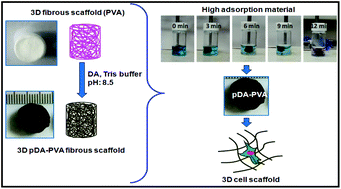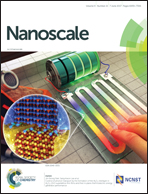A novel approach for fabricating highly tunable and fluffy bioinspired 3D poly(vinyl alcohol) (PVA) fiber scaffolds†
Abstract
The excellent biocompatibility, biodegradability and chemo-thermal stability of poly(vinyl alcohol) (PVA) have been harnessed in diverse practical applications. These properties have motivated the fabrication of high performance PVA based nanofibers with adequate control over the micro and nano-architectures and surface chemical interactions. However, the high water solubility and hydrophilicity of the PVA polymer limits the application of the electrospun PVA nanofibers in aqueous environments owing to instantaneous dissolution. In this work, we report a novel yet facile concept for fabricating extremely light, fluffy, insoluble and stable three dimensional (3D) PVA fibrous scaffolds with/without coating for multifunctional purposes. While the solubility, morphology, fiber density and mechanical properties of nanofibers could be tuned by optimizing the cross-linking conditions, the surface chemical reactivity could be readily enhanced by coating with a polydopamine (pDA) bioinspired polymer without compromising the stability and innate properties of the native PVA fiber. The 3D pDA–PVA scaffolds exhibited super dye adsorption and constructive synergistic cell-material interactions by promoting healthy adhesion and viability of the human mesenchymal stem cells (hMSCs) within 3D micro-niches. We foresee the application of tunable PVA 3D as a highly adsorbent material and a scaffold material for tissue regeneration and drug delivery with close consideration of realistic in vivo parameters.



 Please wait while we load your content...
Please wait while we load your content...